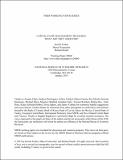Capital-flow management measures: What are they good for?
Author(s)
Fratzscher, Marcel; Straub, Roland; Forbes, Kristin J
Downloadw20860.pdf (613.7Kb)
PUBLISHER_CC
Publisher with Creative Commons License
Creative Commons Attribution
Terms of use
Metadata
Show full item recordAbstract
Are capital controls and macroprudential measures related to international exposures successful in achieving their objectives? Assessing their effectiveness is complicated by selection bias; countries which change their capital-flow management measures (CFMs) often share specific characteristics and are responding to changes in variables that the CFMs are intended to influence. This paper addresses these challenges by using a propensity-score matching methodology. We also create a new database with detailed information on weekly changes in controls on capital inflows, capital outflows, and macroprudential measures related to international transactions from 2009 to 2011 for 60 countries. Results show that these macroprudential measures can significantly reduce some measures of financial fragility. Most CFMs do not significantly affect other key targets, however, such as exchange rates, capital flows, interest-rate differentials, inflation, equity indices, and different volatilities. One exception is that removing controls on capital outflows may reduce real exchange rate appreciation. Therefore, certain CFMs can be effective in accomplishing specific goals-but most popular measures are not "good for" accomplishing their stated aims. Keywords: Capitol controls; Macroprudential measures; Propensity-score matching; Selection bias; Capital flows; Emerging markets
Date issued
2015-01Department
Sloan School of ManagementJournal
Journal of International Economics
Publisher
Elsevier BV
Citation
Forbes, Kristin et al. “Capital-Flow Management Measures: What Are They Good For?” Journal of International Economics 96 (July 2015): S76–S97 © 2014 Elsevier B.V.
Version: Author's final manuscript
ISSN
0022-1996